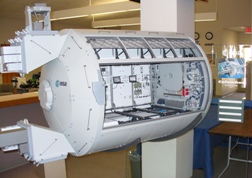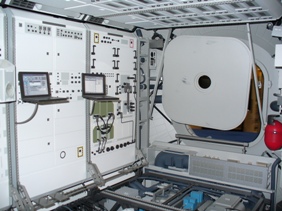December 4, 2007—When Lucia and I headed up to Washington, D.C. for book signings at the Smithsonian, we experienced our share of snags at Orlando International Airport. The auto-pilot broke down before boarding time—so we, the plane, the pilots, the flight attendants, etc. sat around and waited for U.S. Airways to fly-in a replacement part. We got off an hour late, which is nothing compared to the 15 years the European Space Agency has been waiting for Columbus to launch on the Space Shuttle.
 The ten-ton, twenty three foot long lab is seen here in the form of a five-foot long scale model from ESA. The model makers really spent some time on this project, check out the photo below for some of the interior detail. The actual lab was originally intended to fly in 1992 in honor of its namesake. That year, you’ll recall was the four hundredth anniversary of Christopher Columbus’ discovery of the new world. It would have been a PR official’s dream, but that was back when the space station project was known as Space Station Freedom. The outpost wouldn’t start flying as the International Space Station until 1998. Columbus won’t go until Thursday, assuming there are no launch delays. So much for timing.
The ten-ton, twenty three foot long lab is seen here in the form of a five-foot long scale model from ESA. The model makers really spent some time on this project, check out the photo below for some of the interior detail. The actual lab was originally intended to fly in 1992 in honor of its namesake. That year, you’ll recall was the four hundredth anniversary of Christopher Columbus’ discovery of the new world. It would have been a PR official’s dream, but that was back when the space station project was known as Space Station Freedom. The outpost wouldn’t start flying as the International Space Station until 1998. Columbus won’t go until Thursday, assuming there are no launch delays. So much for timing.
 Once the Astronauts dock with the space station, they'll lift Columbus out of the Shuttle’s cargo bay with the robot arms on the station and Atlantis and snap it into the Harmony module, which was left in orbit by the crew of Shuttle Discovery last month. Its designers at the European Space Agency proudly point out that Columbus' job is science—only. That’s in contrast to the U.S. Destiny Lab on the station, which also acts as the station’s command center.
Once the Astronauts dock with the space station, they'll lift Columbus out of the Shuttle’s cargo bay with the robot arms on the station and Atlantis and snap it into the Harmony module, which was left in orbit by the crew of Shuttle Discovery last month. Its designers at the European Space Agency proudly point out that Columbus' job is science—only. That’s in contrast to the U.S. Destiny Lab on the station, which also acts as the station’s command center.
See you on launch day—and we’ll be watching the weather and any other technical "gotcha's" that could delay things.
More to come.